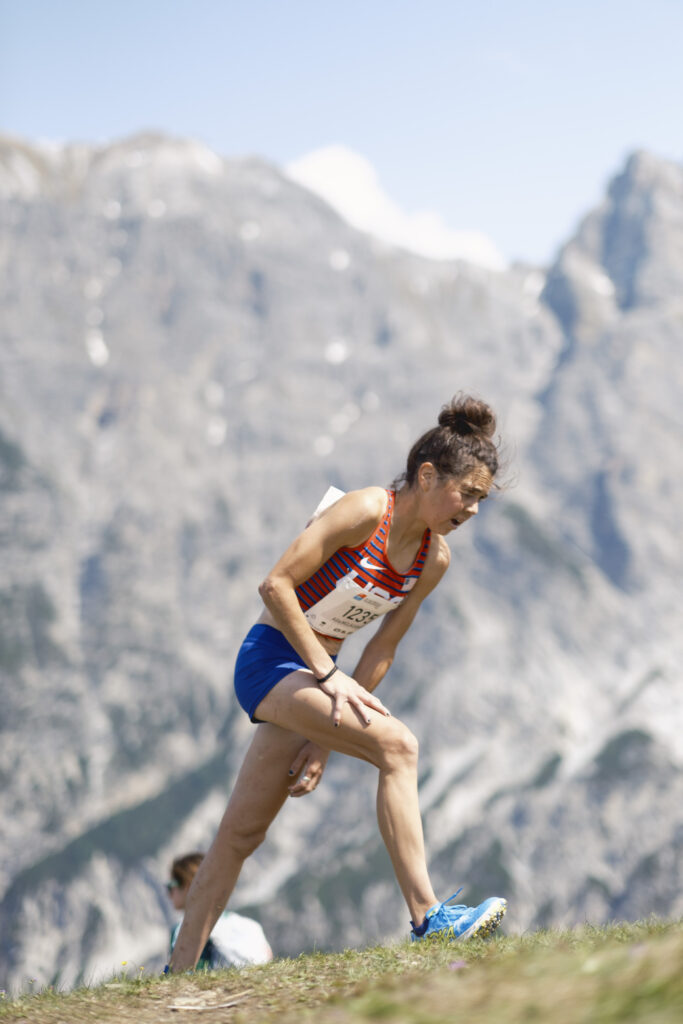Your local terrain, no matter how flat, doesn’t have to hold you back!
We’re trail runners, and often the races we feel drawn towards don’t reflect the terrain we live in. (Who’s got two thumbs and has done this more than once, this girl!) Have you found yourself looking to run a hilly, or vertically challenging, race but unsure about your ability to train for it? Or maybe, you’re wondering how to best prepare for vert when a bridge or a parking garage is the closest thing you have to a hill… Fear not, your best training ground may be the terrain you have, no matter how flat! Sometimes overemphasizing uphills can actually backfire and tank your running performance. No matter what your backyard looks like, in this article, we are going to break down how you can train to tackle terrain that might be a little bit more vertically inclined.
Author’s note: in this article, uphill running is often described in terms of incline, grade, and vert, whereas running on flat terrain is synonymous with level ground running.
The differences Between Flat and Uphill Running
In order to better understand how to train for hilly races, let’s first explore the differences between uphill and flat, or level ground, running: the steeper the grade, the more pronounced these differences become.
According to a 2016 review article titled “Biomechanics and Physiology of Uphill and Downhill Running”, among other studies, uphill running requires its’ own specialized skill set:
- Higher step frequency
- Pretty self-explanatory: running cadence should increase with incline, while aerial time, time spent off the ground, and stride length decrease proportionally. You can think about this like shifting into an easier gear on the bike.
- More mechanical work
- Lower limb muscles and joints have to produce more force, also known as work, to propel the body uphills compared to level and downhill running.
- More power output at the joints, particularly at the hips
- As well as requiring a greater total amount of work, running uphill requires work to be done at a greater rate: power is the rate of work done.
- The hips are the primary uphill running power generators.
- Greater muscular and joint activity
- A wider range of muscles are engaged, with the knee extensor muscles playing a particularly large role.
- Step back with us into Anatomy & Physiology, and you’ll remember that muscles pull on joints to bring about movement – increased joint action is driven by increased muscle action.
- Lower impact forces
- The greater the incline, the lower the impact forces when running, reducing stress on the body and decreasing the risk of some injuries.

Take a Year-round Approach to Training for Hilly Races
A 2018 study titled “Level versus uphill economy and mechanical responses in elite ultra-trail runners” explored the net oxygen and metabolic costs of running in elite ultra-trail athletes during level and uphill running. The researchers reported a strong correlation between level and uphill markers of running economy. Put simply, runners who were more economic on flat terrain were also better uphill runners. This relationship held up until grades above 20%, much steeper inclines than the majority of trail and ultra runners will experience. In the case of these extreme grades, different training guidelines apply since hiking is often more efficient than running, requiring markedly different biomechanics.
When it comes to training, this study, amongst others, makes the case for a well-rounded, non-specific approach to training for much of the year, as opposed to overemphasizing uphill running. Improving fitness and running economy on flatter terrains through a mix of speed work, intervals, and other workouts, together with easy mileage and long runs, will translate into improved uphill running. In short, develop your aerobic system and improve your running economy. This is especially for the flatlanders in the room, be reassured that if you’re fast on flats, you’ll be fast on uphills and downs. That said, logging easy miles on undulating or varied terrains is advisable year-round too.
Additionally, it is well worth incorporating strides – 15 to 30-second bouts of faster running, not sprinting, with recovery in between – into your training after easy runs once or twice a week. If you’re new to strides, start with 4×20-second bouts after one easy run a week, eventually adding a second session to your week and increasing the reps to as many as six to eight. These brief periods of fast, efficient running have been shown to have outsized impacts on running economy.
Why You Shouldn’t Overemphasize Hills
Consider the factors limiting uphill running performance compared to level ground performance and the case against overemphasizing hills will become clear. Uphill running is primarily driven and subsequently limited by muscular activity. In contrast, level running is rarely limited by a sole factor, instead a more balanced interplay of the aerobic and muscular systems, biomechanics, and muscular activity impacts performance. The numerous level running limiting factors mean that there are far more opportunities for improvement compared to uphill running.
Overemphasizing uphill running can be to the detriment of flat running, as well as overall running economy. Why? Well, for the same given effort level, you’ll be moving at a slower pace running uphill than on level ground. By focusing too much on hills, you’re practicing and reinforcing running slow, reducing your top-end speed: simply put, you’ll be getting slower not faster. For those science-minded folks, the research backs this up – flat running economy drives uphill running economy, not vice versa.
How to Move From Generic to Specific Hill Training
Preparing for races with big uphills is a prime example of when the coaching principle of least to most specific training rings especially true. As described above, a well-rounded approach to training, focused on developing the aerobic base and running economy, mixed with hill strides and undulating easy and long runs, is recommended for the majority of the year.
That said, training in the 6-8 weeks before race day should markedly shift in favor of race-specificity. For hilly races, uphill intervals should be incorporated weekly, as well as long runs on terrains similar to race day. Having already developed the aerobic base and running economy on flatter terrains, 1-2 months is plenty of time to stimulate the muscle activity adaptations needed to excel at running uphill. Additionally, just a few exposures to steep terrain is enough for heart rate and running economy to normalize.
To better understand what race-specific training could look like, see an example training week below:
| Mon | Tue | Wed | Thu | Fri | Sat | Sun | |
| AM | Easy run with 4x 30s hill strides | Hill workout:5x 3 minute hills | Easy run or cross train | Rest day | Easy run with 4x 30s hill strides | Hilly long run over race specific terrain | Easy run or cross train |
| PM | Strength training | Strength training |
Hill Workout Examples
Even for athletes preparing for the steepest of races, a hill with 6-8% average grade, something that’s not too technical, and not too steep that you’re not able to run up it is ideal for the following workout examples.
Always make sure to include a warm up and cool down of 15 to 20 minutes of easy jogging. The recovery between each hill interval is the time it takes to jog easily back down the hill to where you started: going as slow as you need to recover.
Workout One:
- 6-8x 90 seconds running uphill with 3 minutes recovery
- 10 minutes tempo at 1-hour effort
Workout Two:
- 8 minutes tempo run at 1-hour effort with 2 minutes recovery
- 5x 2 minute running uphill at 5 km effort with 2 minutes recovery
- 8 minutes tempo run at 1-hour effort
Workout Three:
- 4-5x 3 minute running uphill at 10km effort

Simple Tips to Bring Into Your Weekly Training
Focus on form
- Leaning slightly forward from the hips into the hill will help you counteract the force of gravity pulling you back down the hill.
- Taking short, quick strides allows you to maintain a high power output at a lower level of exertion.
- Focus on forward movement as opposed.
Treadmills are your friend!
- Especially for those in urban areas or locations that are vert-limited, as well as in places that are yet to see the light of spring, embrace the treadmill.
- Play around with the incline on easy and long runs, use the suggested 6-8% for hill intervals, and consider steeper grades for hill strides.
Strength training is about more than being strong.
- Regular strength training allows you to improve the muscular strength and endurance required to generate the power needed to run uphill.
- For maximum benefit, incorporate strength training on fatigued legs, such as after harder workouts or the next day.
- Heavy weights or a gym membership is not required.
- Emphasize single leg exercises like step-ups,single leg deadlifts and squats, and calf raises.
- Eccentric loading in the weight room may help in races with lots of downhill running.
Downhill running is a skill.
- All skills require practice, and downhill running is a skill.
- Stay tuned for an article specifically addressing this soon!
TL:DR
In short, don’t let a lack of hills scare you away from tackling a hilly race! By following a well-rounded approach to training that develops your aerobic base and running economy on flat ground, with specific hill intervals (even if they’re on the treadmill), strides, and strength work layered in, you can set yourself up for a successful race day.
References
Jeker, D., Falbriard, M., Vernillo, G., Meyer, F., Savoldelli, A., Degache, F., Schena, F., Aminian, K., & Millet, G. P. (2020). Changes in spatio-temporal gait parameters and vertical speed during an extreme mountain ultra-marathon. European Journal of Sport Science, 20(10), 1339–1345. https://doi.org/10.1080/17461391.2020.1712480
Skovgaard, C., Christiansen, D., Christensen, P. M., Almquist, N. W., Thomassen, M., & Bangsbo, J. (2018). Effect of speed endurance training and reduced training volume on running economy and single muscle fiber adaptations in trained runners. Physiological Reports, 6(3), e13601. https://doi.org/10.14814/phy2.13601
Vernillo, G., Giandolini, M., Edwards, W.B. et al. Biomechanics and physiology of uphill and downhill running. Sports Med, 47, 615–629 (2017). https://doi.org/10.1007/s40279-016-0605-y
Willis, S. J., Gellaerts, J., Mariani, B., Basset, P., Borrani, F., & Millet, G. P. (2019). Level versus uphill economy and mechanical responses in elite ultra-trail runners. International Journal of Sports Physiology and Performance, 14(7), 1001–1005. https://doi.org/10.1123/ijspp.2018-0365
Zimmermann, P., Müller, N., Schöffl, V., Ehrlich, B., Moser, O., & Schöffl, I. (2022). The energetic costs of uphill locomotion in trail running: Physiological consequences due to uphill locomotion pattern-A feasibility study. Life (Basel, Switzerland), 12(12), 2070. https://doi.org/10.3390/life12122070
